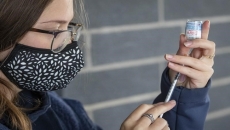Hundreds more British Columbians have joined the thousands already forced from their homes by wildfires as several local governments ordered residents to get out Tuesday night ahead of nearby blazes.
#BCwildfire activity is expected to pick up over the next few days w/ more #EvacuationOrders likely. Now is the time for your emergency plan:
— PreparedBC (@PreparedBC) July 21, 2021
✅Plan to stay with family/friends if possible
✅Gather emergency contact info
✅Check your insurance coverage https://t.co/EMrpF0mbM9 pic.twitter.com/p13A6BLlDT
The Regional District of Kootenay Boundary declared a local state of emergency and ordered 122 properties evacuated, while residents in another 304 properties have been put on alert as the 20-square kilometre Nk'Mip Creek wildfire sweeps east, parallel to the U.S. border.
The fire, sparked Monday, has already forced evacuations between the south Okanagan towns of Oliver and Osoyoos.
It's one of nearly 300 burning across the province — including 39 threatening or highly visible wildfires that the Ministry of Forests says have forced evacuation orders for more than 3,000 properties.
At least half a dozen other evacuation orders were issued Tuesday night, including one affecting the community of Fauquier in southeastern B.C., while a large part of the Shuswap district of Sicamous was also evacuated and more homes are on alert after a vehicle crash caused a fire that spread to nearby bush.
A provincial state of emergency took effect in B.C. at midnight as Public Safety Minister Mike Farnworth says expected strong winds have the potential to whip up existing wildfires and force mass evacuations.
More than 3,000 firefighters and support staff are on the fire lines, including crews from Alberta, New Brunswick and Quebec, while about 100 firefighters from Mexico are due to arrive this weekend and the federal government is sending 350 Canadian Armed Forces members.
Farnworth says he welcomes the help from the military because B.C.'s available resources are fully assigned.
"Air support from Canadian Forces has already proved invaluable in moving crews and equipment throughout the province and aiding in precautionary evacuations," he said in a news release.
The statement does not say when the Armed Forces crews will arrive in B.C., but it says they will be assigned to hold existing fire lines, suppress hot spots and build new fire lines on the highest priority blazes.
-B.C. Premier John Horgan says officials are in talks with the United States and Australia about potential support in fighting some 300 wildfires scorching the province, but COVID-19 and the wildfire situation elsewhere is limiting the help that's available.
Horgan made the comments during a news conference today from Castlegar, where he was touring the BC Wildfire Service's Southeast Fire Centre.
Horgan says the wildfires have ignited just as British Columbia's tourism industry was hoping to begin its recovery from the pandemic, but he promised the province will work with industry and labour groups to support them.
He encouraged anyone with trips planned near the fire zones to check with local resources, including their accommodation providers, to ensure it's safe to travel before leaving.
#BCWildfire update*:
— BC Government News (@BCGovNews) July 21, 2021
• 296 wildfires burning in BC
• 44 evacuation orders
• 74 evacuation alerts
• 310,509 hectares burned
• 3,180 active firefighters & crew
*Data from July 20, 7PM
For the latest updates and supports: https://t.co/ku2qhLnFRr pic.twitter.com/hnBk0g12GD
Hundreds more have joined the thousands already forced from their homes by wildfires as several local governments ordered residents to get out Tuesday night ahead of nearby blazes.
"For those living through yet another horrific fire season, this is a graphic reminder of how climate change is with us, not just intermittently, but all the time," Horgan said.
"We all have to hang together as British Columbians and follow the lead of emergency personnel."






